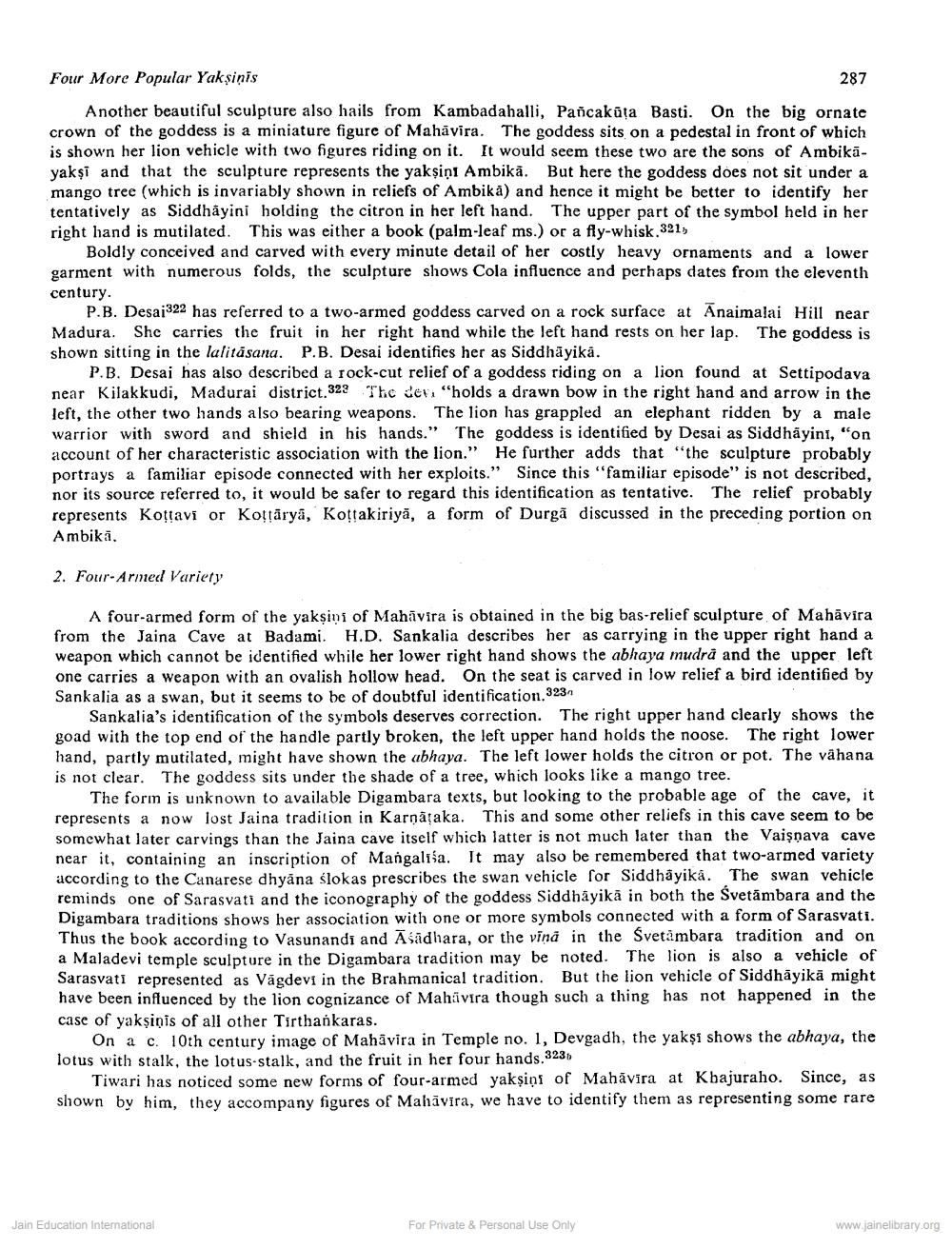________________
Four More Popular Yaksinis
287 Another beautiful sculpture also hails from Kambadahalli, Pancakūta Basti. On the big ornate crown of the goddess is a miniature figure of Mahāvira. The goddess sits on a pedestal in front of which is shown her lion vehicle with two figures riding on it. It would seem these two are the sons of Ambikāyakşi and that the sculpture represents the yakşiņi Ambikā. But here the goddess does not sit under a mango tree (which is invariably shown in reliefs of Ambika) and hence it might be better to identify her tentatively as Siddhãyini holding the citron in her left hand. The upper part of the symbol held in her right hand is mutilated. This was either a book (palm-leaf ms.) or a fly-whisk 321)
Boldly conceived and carved with every minute detail of her costly heavy ornaments and a lower garment with numerous folds, the sculpture shows Cola influence and perhaps dates from the eleventh century.
P.B. Desai322 has referred to a two-armed goddess carved on a rock surface at Anaimalai Hill near Madura. She carries the fruit in her right hand while the left hand rests on her lap. The goddess is shown sitting in the lalitåsana. P.B. Desai identifies her as Siddhāyika.
P.B. Desai has also described a rock-cut relief of a goddess riding on a lion found at Settipodava near Kilakkudi, Madurai district.323 The det. "holds a drawn bow in the right hand and arrow in the left, the other two hands also bearing weapons. The lion has grappled an elephant ridden by a male warrior with sword and shield in his hands.” The goddess is identified by Desai as Siddhāyini, "on account of her characteristic association with the lion." He further adds that "the sculpture probably portrays a familiar episode connected with her exploits." Since this "familiar episode" is not described. nor its source referred to, it would be safer to regard this identification as tentative. The relief probably represents Kottavi or Kottāryā, Kottakiriya, a form of Durgă discussed in the preceding portion on Ambika.
2. Four-Armed Variety
A four-armed form of the yaksini of Mahāvira is obtained in the big bas-relief sculpture of Mahāvira from the Jaina Cave at Badami. H.D. Sankalia describes her as carrying in the upper right hand a weapon which cannot be identified while her lower right hand shows the abhaya mudrå and the upper left one carries a weapon with an ovalish hollow head. On the seat is carved in low relief a bird identified by Sankalia as a swan, but it seems to be of doubtful identification.323"
Sankalia's identification of the symbols deserves correction. The right upper hand clearly shows the goad with the top end of the handle partly broken, the left upper hand holds the noose. The right lower hand, partly mutilated, might have shown the abhaya. The left lower holds the citron or pot. The vähana is not clear. The goddess sits under the shade of a tree, which looks like a mango tree.
The form is unknown to available Digambara texts, but looking to the probable age of the cave, it represents a now lost Jaina tradition in Karnataka. This and some other reliefs in this cave seem to be somewhat later carvings than the Jaina cave itself which latter is not much later than the Vaisnava cave near it, containing an inscription of Mangalia. It may also be remembered that two-armed variety according to the Canarese dhyana ślokas prescribes the swan vehicle for Siddhayika. The swan vehicle reminds one of Sarasvati and the iconography of the goddess Siddhayikā in both the Svetämbara and the Digambara traditions shows her association with one or more symbols connected with a form of Sarasvati. Thus the book according to Vasunandi and Asadhara, or the vina in the Svetambara tradition and on a Maladevi temple sculpture in the Digambara tradition may be noted. The lion is also a vehicle of Sarasvati represented as Vāgdevi in the Brahmanical tradition. But the lion vehicle of Siddhayikä might have been influenced by the lion cognizance of Mahavira though such a thing has not happened in the case of yaksinis of all other Tirtharkaras.
On a c. 10th century image of Mahavira in Temple no. 1, Devgadh, the yakşi shows the abhaya, the lotus with stalk, the lotus stalk, and the fruit in her four hands.323)
Tiwari has noticed some new forms of four-armed yaksiņi of Mahavira at Khajuraho. Since, as shown by him, they accompany figures of Mahavira, we have to identify them as representing some rare
Jain Education International
For Private & Personal Use Only
www.jainelibrary.org




